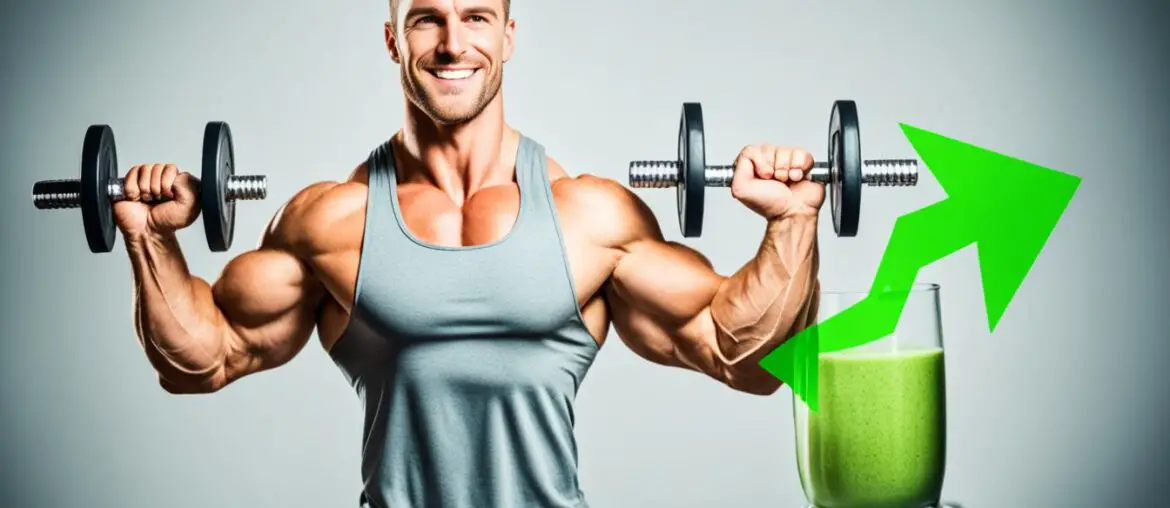Are you considering embarking on the HCG diet but worried about losing muscle mass? Or perhaps you’re already on the HCG diet and wondering if it’s possible to incorporate strength training into your fitness routine. The answer may surprise you. Contrary to popular belief, strength training can actually be beneficial while following the HCG diet. In this article, I will delve into the relationship between strength training and the HCG diet, providing insights and tips for an effective and balanced fitness routine during the program.
Key Takeaways:
- Contrary to popular belief, incorporating strength training into your fitness routine while on the HCG diet can be beneficial.
- Light exercises such as walking, yoga, and gentle biking are generally recommended, while avoiding heavy weight lifting or intense cardio.
- Strength training helps promote muscle retention and prevents muscle loss during periods of calorie restriction.
- Consulting a healthcare provider or a fitness professional is essential for personalized recommendations on effective strength training while following the HCG diet.
- Balancing exercise and calorie intake is crucial for optimal results on the HCG diet.
How Does the HCG Diet Work?
The HCG diet program combines daily injections or drops of HCG with a low-calorie diet to facilitate weight loss. HCG, or human chorionic gonadotropin, helps the body utilize stored fat for energy when calorie consumption is reduced. The diet plan typically focuses on vegetables, lean proteins, fruits, and small amounts of whole grains. The combination of the HCG hormone and a low-calorie diet results in rapid weight loss. It is important to note that while the diet promotes fat loss, it may take time to see actual results. Additionally, temporary water retention may occur during the diet.
“The HCG diet harnesses the power of the HCG hormone to promote weight loss. By combining it with a low-calorie diet, individuals can achieve rapid results. However, it is essential to remember that actual fat loss may take time, so patience is key.”
Effects of Exercise on the HCG Diet
The HCG diet restricts calorie intake, making it important to consider the effects of exercise. While vigorous exercise can slow weight loss on the HCG diet, light exercise can still be beneficial. It is recommended to avoid heavy weight lifting or intense cardio while on the HCG diet to prevent dizziness and exhaustion. However, incorporating activities such as walking, yoga, and easy biking can help maintain muscle tone without jeopardizing weight loss. It is important to listen to your body and consult a healthcare provider for personalized recommendations.
Exercise plays a crucial role in overall health and well-being, and even on the HCG diet, it can have its benefits. While intense workouts are not advised, engaging in light physical activities can still contribute to muscle tone and a sense of well-being. Walking, yoga, and easy biking are low-impact exercises that can be easily incorporated into your daily routine.
Walking: One of the simplest yet effective forms of exercise is walking. It is a low-impact activity that can be easily adjusted to your fitness level. Walking not only helps burn calories but also enhances cardiovascular health and improves mood. Aim for at least 30 minutes of brisk walking every day.
Yoga: Yoga combines gentle movements, stretching, and deep breathing, making it an ideal exercise option while on the HCG diet. It helps improve flexibility, strength, and balance while promoting relaxation and stress reduction. Consider joining a beginner’s yoga class or following online tutorials.
Easy Biking: Biking is a great low-impact exercise that can be enjoyable and effective for maintaining muscle tone. Whether on a stationary bike or outdoors, cycling can increase heart rate, improve endurance, and engage various muscle groups. Start with short, easy rides and gradually increase intensity as your fitness level improves.
Remember, while exercise is beneficial, it is essential to be mindful of your body’s limits while on the HCG diet. Monitor your energy levels, stay hydrated, and adjust the intensity and duration of your activities accordingly. Consulting a healthcare provider, especially if you have any underlying health conditions, can provide personalized recommendations for safe and effective exercising on the HCG diet.
Acceptable Exercises on the HCG Diet

When following the HCG diet, incorporating light exercises can still be beneficial for maintaining overall fitness and muscle tone. However, it is important to choose exercises that are suitable for the low-calorie nature of the diet and avoid excessive stress on the body. Here are some recommended exercises for individuals on the HCG diet:
1. Walking
Walking is a low-impact exercise that can be easily incorporated into your daily routine. It helps burn calories, improve cardiovascular health, and maintain muscle tone. Aim for at least 30 minutes of brisk walking every day to reap the benefits.
2. Yoga
Yoga is an excellent choice for exercising on the HCG diet as it combines gentle movements with deep breathing and mindfulness. It helps improve flexibility, balance, and relaxation. Consider joining a beginner-friendly yoga class or following online tutorials to get started.
3. Gentle Biking
Gentle biking is another low-impact exercise option that can be enjoyed outdoors or on a stationary bike. It provides a cardiovascular workout while minimizing stress on the joints. Start with shorter biking sessions and gradually increase duration and intensity.
It is crucial to remember that while these exercises are generally acceptable on the HCG diet, it is important to listen to your body and avoid pushing yourself too hard, especially if you are new to exercising or have any underlying health conditions.
Consulting a healthcare provider or a pain management specialist can provide additional guidance on maintaining good bone health and managing weight while on the HCG diet. They will be able to assess your individual needs and provide personalized exercise recommendations that align with your goals and overall well-being.
Remember, a balanced fitness routine tailored to your needs can help support your weight loss efforts while on the HCG diet, so don’t hesitate to seek professional guidance.
Benefits of Strength Training on the HCG Diet
While the focus of the HCG diet is rapid weight loss, incorporating strength training can have several benefits. Strength training helps promote muscle retention and prevents muscle loss during periods of calorie restriction. This is important for maintaining a toned and fit physique.
Additionally, strength training can help improve overall body composition and increase metabolism, leading to more efficient weight loss. By building and maintaining muscle mass, strength training on the HCG diet can support long-term weight management and prevent the dreaded rebound effect.
Strength training also offers a range of health benefits beyond weight loss. It promotes bone density, enhances joint stability, and improves overall functional strength. These benefits can reduce the risk of osteoporosis and contribute to a healthier, more active lifestyle.
When incorporating strength training into the HCG diet, it is important to perform exercises that target major muscle groups. Compound movements such as squats, lunges, push-ups, and rows engage multiple muscles simultaneously, resulting in more effective workouts.
Remember, it is crucial to follow appropriate recommendations and consult a healthcare provider for personalized advice. They can help tailor a strength training routine that is safe and suitable for your specific needs and goals. With the right approach, strength training can be a powerful ally in achieving your desired results on the HCG diet.
Tips for Incorporating Strength Training on the HCG Diet:
- Start with light weights or bodyweight exercises and gradually increase intensity.
- Perform compound exercises that target multiple muscle groups.
- Focus on proper form and technique to maximize effectiveness and prevent injuries.
- Include a variety of exercises to work different muscle groups.
- Listen to your body and rest when needed to avoid overtraining.
Quote:
“Strength training on the HCG diet can have a positive impact on muscle retention and body composition. It not only supports weight loss but also offers numerous health benefits. Incorporating strength training into your routine can help you achieve and maintain your fitness goals.”
Maximizing Results with Strength Training on the HCG Diet

To maximize results with strength training on the HCG diet, it is important to focus on proper form and intensity. Building muscle on the HCG diet can be challenging due to the low-calorie nature of the program. However, with effective strength training techniques, you can maximize muscle retention while achieving your weight loss goals.
One key strategy is to incorporate compound exercises that target multiple muscle groups simultaneously. This allows you to make the most out of your workout time and engage different muscles for optimal results. Examples of compound exercises include squats, deadlifts, lunges, and push-ups.
Another important aspect is gradually increasing the resistance and challenging yourself with progressive overload. This means gradually increasing the weights you lift or the difficulty of bodyweight exercises over time. By consistently challenging your muscles, you can stimulate growth and promote muscle retention.
However, it is crucial to listen to your body and avoid overexertion. The HCG diet is a low-calorie program, and pushing yourself too hard can lead to fatigue and potential muscle loss. It is advisable to consult a healthcare provider or a fitness professional who can provide personalized guidance based on your specific needs and goals.
“Incorporating compound exercises and progressively increasing resistance are key strategies for building muscle and maximizing results on the HCG diet.”
| Effective Strength Training Tips on the HCG Diet |
|---|
| Focused on compound exercises |
| Gradually increase resistance |
| Listen to your body |
| Consult a healthcare provider or fitness professional |
By following these guidelines, you can effectively build muscle and maximize muscle retention while on the HCG diet. Remember to prioritize proper form, gradually increase resistance, and seek professional guidance when needed. With a balanced approach to strength training, you can achieve optimal results and maintain a fit and healthy body.
How to Maintain Muscle While on the HCG Diet
To successfully maintain muscle while on the HCG diet, it is essential to implement effective strategies that prioritize both nutrition and exercise. By following these muscle retention strategies during the HCG diet, you can support your body’s muscle growth and prevent muscle loss.
Eating Sufficient Protein
Consuming sufficient protein is crucial for muscle growth and repair. Focus on incorporating lean protein sources into your meals, such as chicken, fish, tofu, and other plant-based protein options. Aim to meet your protein needs to support muscle maintenance while on the HCG diet.
Incorporating Strength Training
Regular strength training exercises that target major muscle groups are key to preserving muscle mass during the HCG diet. Design a balanced strength training routine that includes exercises like squats, lunges, push-ups, and rows. Aim to perform these exercises at least twice a week to help maintain and strengthen your muscles.
“Strength training exercises that target major muscle groups are key to preserving muscle mass during the HCG diet.”
Striking a Balance
Striking a balance between calorie restriction and muscle maintenance is crucial during the HCG diet. While it is necessary to adhere to the low-calorie nature of the diet for weight loss, it is equally important to prioritize muscle retention. Consult with a healthcare provider or a registered dietitian to ensure that your calorie intake supports both weight loss and muscle maintenance.
| Food | Protein Content |
|---|---|
| Chicken Breast (3 oz) | 26 grams |
| Tofu (1/2 cup) | 10 grams |
| Salmon (3 oz) | 22 grams |
| Greek Yogurt (1 cup) | 23 grams |
Source: nutritiondata.self.com
By incorporating these muscle retention strategies and maintaining a balanced approach to nutrition and exercise, you can successfully preserve your muscle mass while on the HCG diet. Remember to listen to your body and consult with a healthcare provider or a fitness professional for personalized guidance.
Balancing Exercise and Calorie Intake on the HCG Diet

When following the HCG diet, finding a balance between exercise and calorie intake is key to achieving your weight loss goals. While light exercise is generally acceptable, it is important to avoid excessive calorie burn that could hinder your progress. Adjusting the intensity and duration of your workouts to match the low-calorie nature of the diet will help you maintain a healthy balance.
Monitoring your energy levels is essential when exercising on a low-calorie diet. Be mindful of signs of fatigue or exhaustion, as these may indicate that you are pushing yourself too hard. It’s crucial to listen to your body and give yourself proper rest and recovery time.
Staying hydrated is also important for maintaining a balanced fitness routine on the HCG diet. Drinking enough water throughout the day will help you stay energized and prevent dehydration, especially during exercise.
“Finding the right balance between exercise and calorie intake is crucial for successful weight loss on the HCG diet.”
It’s worth noting that the HCG diet is a low-calorie diet, which means that your calorie intake is already restricted. As a result, it’s important to choose workouts that are appropriate for your energy levels and that won’t overly deplete your calorie reserves.
When designing your exercise routine on the HCG diet, consider incorporating a combination of light cardio exercises and strength training. Walking, yoga, and gentle biking are excellent choices for cardio, as they can help maintain cardiovascular fitness without placing excessive stress on your body.
Strength training exercises, focusing on bodyweight movements or lighter weights, can help maintain muscle tone and promote muscle retention during weight loss. Remember to prioritize proper form and technique, and gradually increase the intensity of your strength training workouts over time.
To summarize, balancing exercise and calorie intake on the HCG diet is essential for optimal results. By adjusting the intensity and duration of your workouts, monitoring your energy levels, staying hydrated, and listening to your body’s cues, you can maintain a successful fitness routine while following the HCG diet.
| Exercise Guidelines on the HCG Diet | Suggestions for Balancing Exercise and Calorie Intake |
|---|---|
| 1. Choose light cardio exercises such as walking, yoga, or gentle biking. | 1. Adjust the duration and intensity of your workouts to match your low-calorie diet. |
| 2. Incorporate strength training exercises focusing on bodyweight movements or lighter weights. | 2. Listen to your body and prioritize rest and recovery to avoid overexertion. |
| 3. Monitor your energy levels and adjust your exercise routine accordingly. | 3. Stay hydrated by drinking enough water throughout the day, especially during workouts. |
| 4. Prioritize proper form and technique during strength training exercises. | 4. Gradually increase the intensity of your strength training workouts over time. |
Incorporating Cardiovascular Exercise on the HCG Diet

While the emphasis of the HCG diet is on strength training and muscle retention, incorporating cardiovascular exercise can still have significant benefits for overall health and well-being. Adding light to moderate forms of cardio to your fitness routine can help improve cardiovascular fitness, boost metabolism, and support weight loss.
Examples of suitable cardiovascular exercises on the HCG diet include brisk walking, gentle cycling, swimming, and low-impact aerobics. These activities can be performed at a moderate intensity to elevate the heart rate without putting excessive strain on your body.
It’s important to avoid high-intensity cardio or long-duration sessions that could lead to excessive calorie burn. Remember, the HCG diet is a low-calorie program, and excessive cardio can interfere with the desired weight loss results. Stick to maintaining a moderate pace and duration that is appropriate for your current fitness level and the calorie restrictions of the diet.
If you’re unsure about the appropriate cardiovascular exercise guidelines while on the HCG diet, it’s always best to consult with a healthcare provider or a fitness professional. They can provide personalized recommendations based on your individual needs and goals.
Benefits of Cardiovascular Exercise on the HCG Diet
Incorporating cardiovascular exercise on the HCG diet offers a range of benefits that go beyond weight loss. Some of the advantages include:
- Improved cardiovascular health
- Increased endurance and stamina
- Enhanced mood and mental well-being
- Reduced stress levels
- Better sleep quality
By combining strength training with cardiovascular exercise, you can maintain a well-rounded fitness routine while on the HCG diet. This balanced approach supports overall health, helps preserve muscle mass, and aids in achieving your weight loss goals.
Tips for a Balanced Fitness Routine on the HCG Diet

To maintain a balanced fitness routine on the HCG diet, follow these tips to ensure optimal results:
- Start with light exercises: Begin your fitness routine with low-impact activities such as walking or stretching. These gentle exercises will help prepare your body for more intense workouts.
- Gradually increase intensity: As you become more comfortable with your routine, gradually increase the intensity of your workouts. This will help challenge your muscles and promote further progress.
- Focus on strength training: Incorporate strength training exercises that target major muscle groups. This will help maintain muscle mass while on the HCG diet and support overall fitness.
- Take rest and recovery days: Rest days are just as important as exercise days. Give your body time to recover and repair, allowing for optimal muscle growth and preventing overtraining.
- Stay consistent: Stick to your exercise routine regularly. Consistency is key to see progress and reap the benefits of your fitness efforts.
- Listen to your body: Pay attention to how your body feels during and after exercise. If something feels uncomfortable or causes pain, modify or stop the exercise. Your body’s needs should always be your top priority.
By following these tips, you can maintain a balanced and effective fitness routine while on the HCG diet. Remember to consult with a healthcare provider or a fitness professional for personalized recommendations that align with your specific needs and goals.
| Benefits of a Balanced Fitness Routine on the HCG Diet | Exercise Tips for the HCG Diet |
|---|---|
|
|
The Importance of Personalized Recommendations

When it comes to exercise on the HCG diet, personalized recommendations are key. Each individual is unique, and what works for one person may not work for another. That’s why consulting a healthcare provider, a registered dietitian, or a fitness professional is crucial for tailored guidance based on your specific needs and goals.
These professionals have the knowledge and experience to provide personalized exercise recommendations on the HCG diet. They will take into account factors such as your current fitness level, any underlying health conditions, and the specifics of your HCG diet plan.
By working with a healthcare provider, registered dietitian, or fitness professional, you can ensure that you are exercising safely and effectively while on the HCG diet. They will help you create a fitness routine that aligns with your weight loss goals and supports your overall health.
Remember, the HCG diet is a unique program, and it’s important to have guidance from professionals who understand its nuances. By seeking personalized recommendations, you can maximize your results and stay on track with your fitness journey.
Conclusion
In conclusion, incorporating strength training while following the HCG diet can have numerous benefits for maintaining muscle mass and supporting overall health. It is important to prioritize light exercises such as walking, yoga, and gentle biking, as these activities are generally recommended during the HCG diet. However, heavy lifting and intense cardio should be avoided to prevent exhaustion and possible interference with weight loss goals.
Striking a balance between calorie restriction and exercise is crucial in order to maximize results. Consulting a healthcare provider or a fitness professional can provide personalized recommendations based on your specific needs and goals. They can ensure that you are exercising safely and effectively while following the HCG diet.
Remember to listen to your body and prioritize proper nutrition throughout your fitness journey on the HCG diet. By combining strength training with a balanced diet, you can achieve optimal muscle retention and overall well-being. Embrace the process and enjoy the transformation towards a healthier, fitter self.
FAQ
Can I exercise while on the HCG diet?
Yes, incorporating light exercise is generally acceptable during the HCG diet. However, it is important to avoid vigorous exercise that may hinder weight loss.
What exercises are recommended on the HCG diet?
Light exercises such as walking, yoga, and gentle biking are generally recommended on the HCG diet. These activities help maintain muscle tone without placing excessive stress on the body.
Is strength training beneficial during the HCG diet?
Yes, strength training can help promote muscle retention and prevent muscle loss while on the HCG diet. It also helps improve body composition and increase metabolism for more efficient weight loss.
How can I maximize results with strength training on the HCG diet?
To maximize results, focus on proper form and intensity during strength training. Incorporating compound exercises that target multiple muscle groups can be highly effective. Gradually increase resistance and challenge yourself with progressive overload.
How do I maintain muscle while on the HCG diet?
To maintain muscle, consume sufficient protein and include lean protein sources in your meals. Additionally, incorporating strength training exercises that target major muscle groups at least twice a week can help preserve muscle mass.
How do I balance exercise and calorie intake on the HCG diet?
It is important to adjust the intensity and duration of exercise to match the low-calorie nature of the diet. Avoid excessive calorie burn that could hinder weight loss. Monitor energy levels, stay hydrated, and listen to your body’s cues for a successful fitness routine on the HCG diet.
Can I do cardio while on the HCG diet?
Yes, light to moderate forms of cardio, such as brisk walking or gentle cycling, can be incorporated on the HCG diet. However, it is important to avoid high-intensity cardio or long-duration sessions that may lead to excessive calorie burn.
What tips can you provide for a balanced fitness routine on the HCG diet?
Start with light exercises and gradually increase intensity as you feel comfortable. Focus on strength training exercises that target major muscle groups. Prioritize proper rest and recovery. Stay consistent with your exercise routine and listen to your body’s needs.
Why is it important to seek personalized recommendations for exercise on the HCG diet?
Every individual is unique, and personalized recommendations for exercise on the HCG diet are crucial. Consulting a healthcare provider, a registered dietitian, or a fitness professional can provide tailored guidance based on your specific needs and goals.




